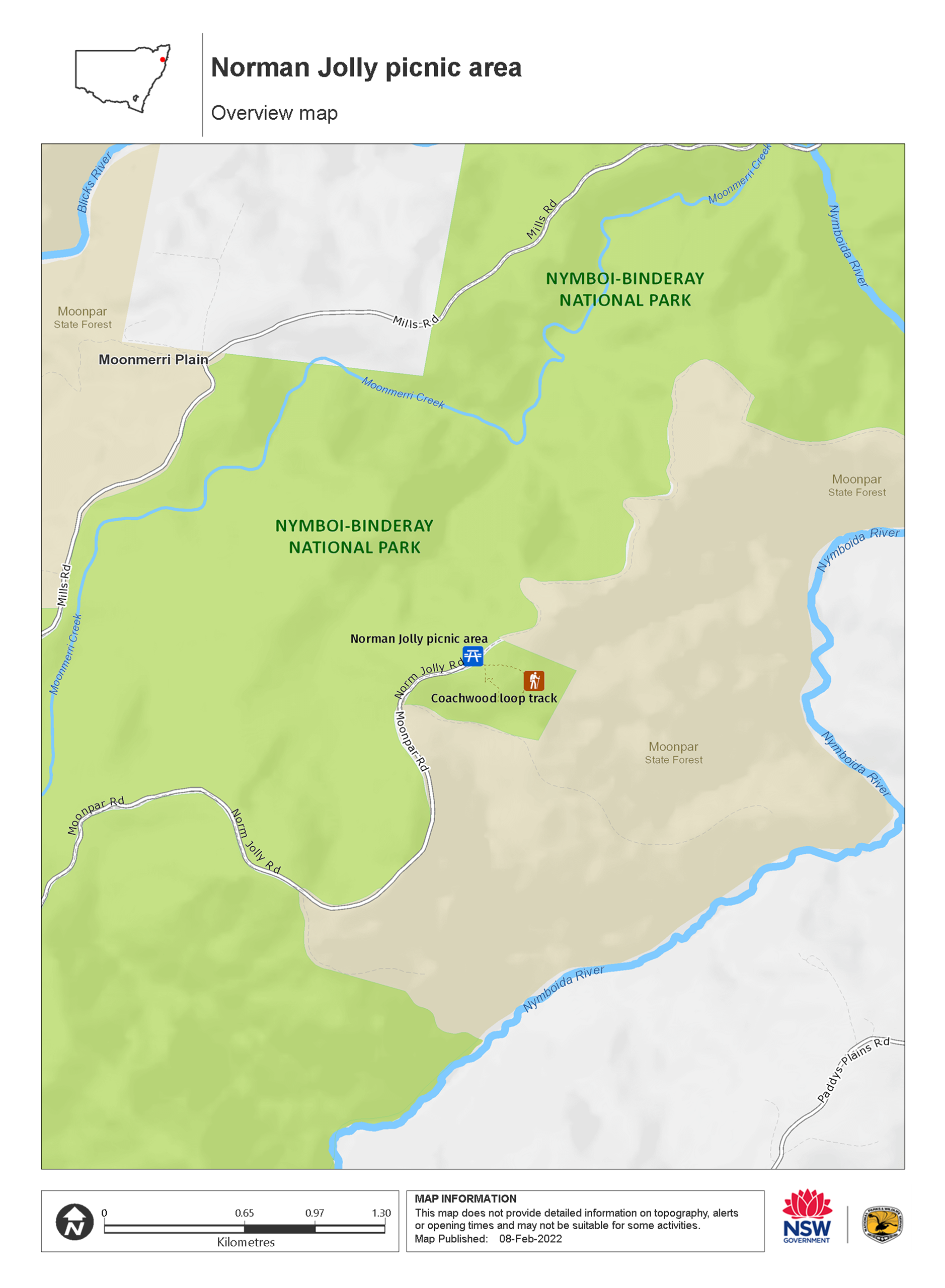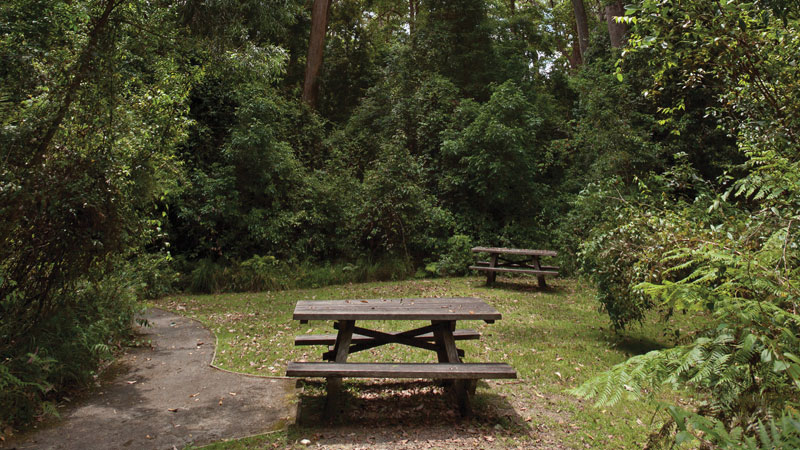Overview
Enjoy a picnic among tall old-growth trees and historic logging relics at Norman Jolly picnic area in Nymboi-Binderay National Park, not far from Dorrigo.
- Type
- Picnic areas
- Where
- Nymboi-Binderay National Park in North Coast
- Accessibility
- Easy
The first thing you’ll notice at Norman Jolly picnic area is the gigantic old-growth trees, the largest of which stand up to 55 metres tall and a couple of metres wide. They are thought to be up to 800 years old and make this a scenic and peaceful place to picnic and relax for the afternoon. If you have time, walk the easy Coachwood loop track which starts from the picnic area.
Dedicated to 19th century forester Norman Jolly who made an important contribution to the teaching and practice of forestry in Australia, you’ll notice a couple of historic logging arches that are relics of a time when this land was logged.
Platypus Flat campground is close by if you want to stay overnight or follow Moonpar Forest drive for a scenic return trip to Dorrigo.
Map

Map legend

Local alerts
For the latest updates on fires, closures and other alerts in this area, see https://www.nationalparks.nsw.gov.au/things-to-do/picnic-areas/norman-jolly-picnic-area/local-alerts
General enquiries
- National Parks Contact Centre
- 7am to 7pm daily
- 1300 072 757 (13000 PARKS) for the cost of a local call within Australia excluding mobiles
- parks.info@environment.nsw.gov.au
Park info
- in Nymboi-Binderay National Park in the North Coast region
Nymboi-Binderay National Park is always open but may have to close at times due to poor weather or fire danger.
Visitor info
All the practical information you need to know about the Norman Jolly picnic area.
Getting there and parking
Norman Jolly picnic area is in Nymboi-Binderay National Park. To get there:
- From Dorrigo, travel north along Tyringham Road
- Turn right into Moonpar Road
- Norman Jolly picnic area is located at the end of Moonpar Road.
Road quality
Check the weather before you set out as the road to Norman Jolly picnic area can become boggy when it rains.
- Unsealed roads
Vehicle access
- 2WD vehicles
Weather restrictions
- Dry weather only
Parking
Parking is available at Norman Jolly picnic area
Best times to visit
There are lots of great things waiting for you in Nymboi-Binderay National Park. One of the highlights of a visit to the park is a whitewater rafting trip down the Nymboida River. Spring is a great time to head out on a guided tour.
Weather, temperature and rainfall
Summer temperature
Average
18°C and 29°C
Winter temperature
Average
5°C and 20°C
Rainfall
Wettest month
March
Driest month
August
The area’s highest recorded rainfall in one day
388mm
Facilities
Water is not available at the picnic area so you'll need to bring your own supply.
Toilets
There's an ambulant non-flush toilet at the picnic area.
- Non-flush toilets
Picnic tables
Step-free access
The picnic area is flat and step-free, with a 1m-wide walkway made of concrete pavers that goes across Norman Jolly Road to the toilets.
Some picnic tables are along the path, but you'll need to cross over short stretches of flat grass to reach the others.
- Step-free outdoor pathways
Maps and downloads
Accessibility
Disability access level - easy
Norman Jolly picnic area is flat and step-free, with the following accessible facilities:
- An ambulant toilet set at the end of a paved path
- Accessible picnic tables, some of which are set along the path. You'll need to cross over short stretches of flat grass to reach the others.
Prohibited
Pets
Pets and domestic animals (other than certified assistance animals) are not permitted. Find out which regional parks allow dog walking and see the pets in parks policy for more information.
Smoking
NSW national parks are no smoking areas.
Learn more
Norman Jolly picnic area is in Nymboi-Binderay National Park. Here are just some of the reasons why this park is special:
Ancient connections

Nymboi-Binderay National Park is the traditional Country of the Gumbaynggirr People and their ancient connection to this land is evident throughout the park. The park's landscape provided a rich source of food, medicine and shelter for Aboriginal people and features strongly in cultural knowledge and Dreaming stories. As you travel through this park, take some time to think about the people who lived here and their strong attachment to this ancient landscape and all it contains.
Animal kingdom

Nymboi-Binderlay has a diverse range of animals, including 68 types of mammal, 25 kinds of amphibian, 33 sorts of reptile and over 120 bird species; of these, at least 15 species are threatened. When you’re picnicking, camping or walking through the tallowwood and coachwood rainforests, be sure to keep your eyes open for the many native animals which call this place home.
- Moonpar Forest drive Moonpar Forest drive is a 75km scenic car touring route near Dorrigo. It’s a great day out and an ideal way to explore the walks, riverside picnic spots, and sights of Nymboi-Binderay and Cascade national parks.
- Norman Jolly picnic area Enjoy a picnic among tall old-growth trees and historic logging relics at Norman Jolly picnic area in Nymboi-Binderay National Park, not far from Dorrigo.
Waterworld

The Nymbodia River is a true highlight of Nymboi-Binderay National Park. The name of the park comes from Aboriginal language of the local Gumbaynggirr People; 'Nymboi' being their name for the river, and 'Binderay' meaning river. Rafting down the Nymboi River with an expert guide is an exhilarating experience and a fantastic way to take in the park's landscape.
- Coachwood loop track The Coachwood loop track is a short and easy walk that starts and finishes at the Norman Jolly picnic area in Nymboi-Binderay National Park.
- Moonpar Forest drive Moonpar Forest drive is a 75km scenic car touring route near Dorrigo. It’s a great day out and an ideal way to explore the walks, riverside picnic spots, and sights of Nymboi-Binderay and Cascade national parks.
Plants and animals protected in this park
Animals
-

Koala (Phascolarctos cinereus)
One of the most renowned Australian animals, the tree-dwelling marsupial koala can be found in gum tree forests and woodlands across eastern NSW, Victoria and Queensland, as well as in isolated regions in South Australia. With a vice-like grip, this perhaps most iconic but endangered Australian animal lives in tall eucalypts within a home range of several hectares.
-

Superb lyrebird (Menura novaehollandiae)
With a complex mimicking call and an elaborate courtship dance to match, the superb lyrebird is one of the most spectacular Australian animals. A bird watching must-see, the superb lyrebird can be found in rainforests and wet woodlands across eastern NSW and Victoria.
-

Southern boobook (Ninox novaeseelandiae)
The southern boobook, also known as the mopoke, is the smallest and most common native owl in Australia. With a musical 'boo-book' call that echoes through forests and woodlands, the southern boobook is a great one to look out for while bird watching.
Plants
-

Wonga wonga vine (Pandorea pandorana)
The wonga wonga vine is a widespread vigorous climber usually found along eastern Australia. A variation of the plant occurs in the central desert, where it resembles a sprawling shrub. One of the more common Australian native plants, the wonga wonga vine produces bell-shaped white or yellow flowers in the spring, followed by a large oblong-shaped seed pod.
-

Blueberry ash (Elaeocarpus reticulatus)
The blueberry ash is a rainforest shrub which produces blue olive-shaped berries and spectacular bell-shaped flowers, which often appear on the plant together. It is a tall slender shrub or small tree found in rainforest, tall eucalypt forest and coastal bushland in eastern NSW, south-east Queensland and Victoria.

